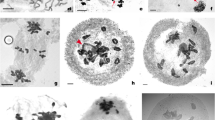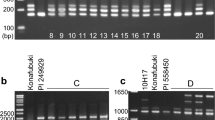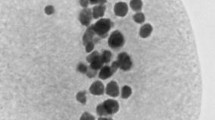Summary
The F1 hybrids from crosses of 59 accessions of wild and cultivated Triticum types including amphidiploids T. boeoticum-Ae. squarrosa, T. timopheevi-Ae. squarrosa, T. timopheevi-T. monococcum, T. boeoticum (4n), T. macha, and T. Zhukovskyi with T. durum Sel. 56-1 and/or T. aestivum were examined for male sterility and chromosome pairing at metaphase I of meiosis in pollen mother cells. Those hybrids which produced male-sterile F1's were recurrently backrossed with pollen from T. durum or T. aestivum to study segregation for male sterility and/or to confirm cytoplasmic male sterility.
All T. timopheevi and T. araraticum accessions and several T. dicoccoides types, including T. dicoccoides var. nudiglumis from the Turkey-Iran-Iraq area, had male sterility inducing cytoplasm. The chromosome pairing in the F1 hybrids indicated that all tetraploid Triticum accessions with male sterility inducing cytoplasm had genome AAGG. T. dicoccoides Körn types from the Turkey-Iran-Iraq area had genomes AABB and did not have male sterility inducing cytoplasm. Therefore, T. dicoccoides Körn and the T. timopheevi complex differ from each other cytoplasmically and cytogenetically and occur sympatrically in the Turkey-Iran-Iraq area.
Possibly, the cytoplasm of the emmers was not derived from the putative diploid progenitors, T. boeoticum, Ae. speltoides, or Ae. bicornis as indicated by their nucleo-cytoplasmic and cytogenetic relationships with the tetraploid Triticum species. The cytoplasmic differences among Ae. speltoides, T. araraticum and T. timopheevi are of a relatively smaller magnitude than the cytoplasmic differences among T. timopheevi, T. boeoticum, and the emmers. A complete analysis of nucleo-cytoplasmic relationships among Triticum and Aegilops species may indicate the cytoplasmic donor(s) to the two tetraploid Triticum species complexes.
Similar content being viewed by others
References
Dagan, J., & D. Zohary, 1970. Wild tetraploid wheats from west Iran cytogenetically identical with Israeli T. dicoccoides. Wheat Inf. Serv., Kyoto Univ., No 31: 15–17.
Feldman, F., 1966. Identification of unpaired chromosomes in F1 hybrids involving Triticum aestivum and T. timopheevi. Can. J. Genet. Cytol. 8: 144–151.
Harlan, J. R., & D. Zohary, 1966. Distribution of wild wheats and barley. Science 153: 1074–1080.
Johnson, B. L., 1967. Tetraploid wheats: seed protein electrophoretic patterns of the emmer and timopheevi groups. Science 158: 131–132.
Johnson, B. L., & D. Hall, 1966. Electrophoretic studies of species relationships in Triticum. Acta agric. scand., Suppl. 16: 222–24.
Jakubzinger, M. M., 1933. Natural growing places of wild wheat in USSR. Prinoda (8–9): 98–102. (in Russian).
Jakubzinger, M. M., 1950. New data about wheat T. araraticum Jakubz. Bull. Appl. Bot. Genet. Breed. 28: 199–200.
Jakubzinger, M. M., 1957. Botanical chracters of wheat. pp. 68–122, In: P. M. Zhukovski, Wheat in the USSR. Agric. Publ., Moscow (in Russian).
Jakubzinger, M. M., 1958. New wheat species. Proc. 1 st Int. Wheat Genet. Symp., pp. 207–217.
Kihara, H., 1919. Über cytologische studien bei einigen Getreidearten. I. Species-Bastarde des Weizens und Weizenroggen-Bastarde. Bot. Mag. (Tokyo) 32: 17–38.
Kihara, H., 1965. The origin of wheat in the light of comparative genetics. Jap. J. Genet. 40: 45–54.
Kihara, H., 1966. Factors affecting the evolution of common wheat. Indian J. Genet. 26A: 14–28.
Kimber, G., & R. S. Athwal, 1972. A reassessment of the course of evolution of wheat. Proc. Natn. Acad. Sci. USA 69(4) 912–915.
Kostoff, D., 1936. The genomes of Triticum timopheevi Zhuk., Secale cereale L., and Haynaldia villosa Schu. Z. indukt. Abstamm.-u. VererbLehre 72: 115–118.
Lilienfeld, F., & H. Kihara, 1934. Genomanalyse bei Triticum und Aegilops. V. Triticum timopheevi Zhuk. Cytologia 6: 67–122.
Lilienfeld, F. & H. Kihara, 1951. Genome-analysis in Triticum and Aegilops X. Concluding review, Cytologia 16: 101–123.
Maan, S. S. & K. A. Lucken, 1970. Interaction of Triticum boeoticum cytoplasm and the genomes of T. aestivum and T. durum: Restoration of male fertility and plant vigor. Euphytica 19: 498–508.
Maan, S. S. & K. A. Lucken, 1971. Nucleo-cytoplasmic interactions involving Aegilops cytoplasms and Triticum genomes. J. Hered. 62: 149–152.
Maan, S. S. & K. A. Lucken, 1972. Interacting male sterility-male fertility restoration systems for hybrid wheat research. Crop Sci. 12: 360–364.
McFadden, E. S. & E. R. Sears, 1946. The origin of Triticum spelta and its free threshing hexaploid relatives. J. Hered, 37: 81–89, 107–116.
Rao, P. S. & E. L. Smith, 1968. Studies with Israeli and Turkish accessions of Triticum turgidum L. emend. var, dicoccoides (Körn) Bowden. Wheat Inf. Serv., Kyoto Univ. 26: 6–7.
Riley, R., J. Unrau & V. Chapman, 1958. Evidence on the origin of the B genome of wheat. J. Hered. 49: 90–98.
Sachs, L., 1953. Chromosome behavior in species hybrids with Triticum timopheevi. Heredity 7: 49–58.
Sarkar, P. & G. L. Stebbins, 1956. Morphological evidence concerning the origin of the B genome in wheat. Am. J. Bot. 43: 297–304.
Sears, E. R., 1956a. The systematics, cytology and genetics of wheat. In: H. Kappert & W. Rudorf, Handbuch der Pflanzenzüchtung, 2nd ed., p. 164–187. Paul Parey, Berlin and Hamburg.
Sears, E. R., 1956b. The B genome of Triticum. Wheat Inf. Serv., Kyoto Univ. 4: 8–10.
Sears, E. R., 1969. Wheat cytogenetics. A. Rev. Genet. 3: 451–468.
Svetozarova, V. V., 1939. Second genome of Triticum timopheevi Zhuk. C. r. Acad. Sci USSR 23: 473–477.
Tanaka, M. & S. Ishikawa. 1968. Cytogenetical examinations of Triticum araraticum Jakubz., a wild type tetraploid wheat species. Genetics 60: 229.
Wagenaar, E. B., 1961. Studies on the genome constitution of Triticum timopheevi Zhuk. I. Evidence for genetic control of meiotic irregularities in tetraploid hybrids. Can. J. Genet. Cytol. 3: 47–60.
Wagenaar, E. B., 1966. Studies on the genome constitution of Triticum timopheevi Zhuk. II. The T. timopheevi complex and its origin. Evolution 20: 150–164.
Wagenaar, E. B., 1970. Studies on the genome constitution of Triticum timopheevi Zhuk. III. Segregation of meiotic chromosome behavior in backcross generations. Can. J. Genet. Cytol. 12: 347–355.
Waines, J. G., 1970. Protein electrophoretic patterns of Transcaucasian wheats. Wheat Inf. Serv., Kyoto Univ. No 31: 12.
Yamashita, K. & M. Tanaka, 1968. New materials of Triticum and Aegilops for genetic studies collected by Kyoto University Scientific Expeditions. In: K. W. Finley & K. W. Sheppard (Ed.), Proc. 3rd, int. Wheat Genet. Symp. (Canberra): 155–160. Butterworths, Sydney.
Zhukovsky, P. M., 1924. Triticum dicoccum Schrank dicoccoides Körn in Georgia. Sci, Pap. Appl. Sect. Tiflis Bot. Gard. 3: 1–3.
Zhukovsky, P. M., 1928. A new species of wheat. Bull. appl. Bot, Genet. Pl. Breed. 19: 59–66.
Author information
Authors and Affiliations
Additional information
Authorized for publication 19 July, 1972 as Paper No 397 in the Journal Series of the North Dakota Agricultural Experiment Stations.
Rights and permissions
About this article
Cite this article
Maan, S.S. Cytoplasmic and cytogenetic relationships among tetraploid Triticum species. Euphytica 22, 287–300 (1973). https://doi.org/10.1007/BF00022637
Received:
Issue Date:
DOI: https://doi.org/10.1007/BF00022637




